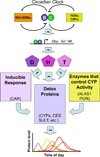Xenobiotic metabolism in the fourth dimension: PARtners in time
- PMID: 16814725
- PMCID: PMC3760144
- DOI: 10.1016/j.cmet.2006.06.002
Xenobiotic metabolism in the fourth dimension: PARtners in time
Abstract
A significant portion of the transcriptome in mammals, including the PAR bZIP transcription factors DBP, HLF, and TEF, is under circadian clock control. In this issue of Cell Metabolism, Gachon and colleagues (Gachon et al., 2006) show that disruption of these three genes in mice alters gene expression patterns of many proteins involved in drug metabolism and in liver and kidney responses to xenobiotic agents. Triple mutant mice have severe physiological deficits, including increased hypersensitivity to xenobiotic agents and premature aging, highlighting the profound effect the circadian clock has on this important response system.
Figures

Comment on
-
The circadian PAR-domain basic leucine zipper transcription factors DBP, TEF, and HLF modulate basal and inducible xenobiotic detoxification.Cell Metab. 2006 Jul;4(1):25-36. doi: 10.1016/j.cmet.2006.04.015. Cell Metab. 2006. PMID: 16814730
References
-
- Gachon F, Olela FF, Schaad O, Descombes P, Schibler U. The circadian PAR-domain basic leucine zipper transcription factors DBP, TEF, and HLF modulate basal and inducible xenobiotic detoxification. Cell Metabolism. 2006 - PubMed
-
- Hastings MH, Reddy AB, Maywood ES. A clockwork web: circadian timing in brain and periphery, in health and disease. Nat Rev Neurosci. 2003;4:649–661. - PubMed
Publication types
MeSH terms
Substances
Grants and funding
LinkOut - more resources
Full Text Sources

